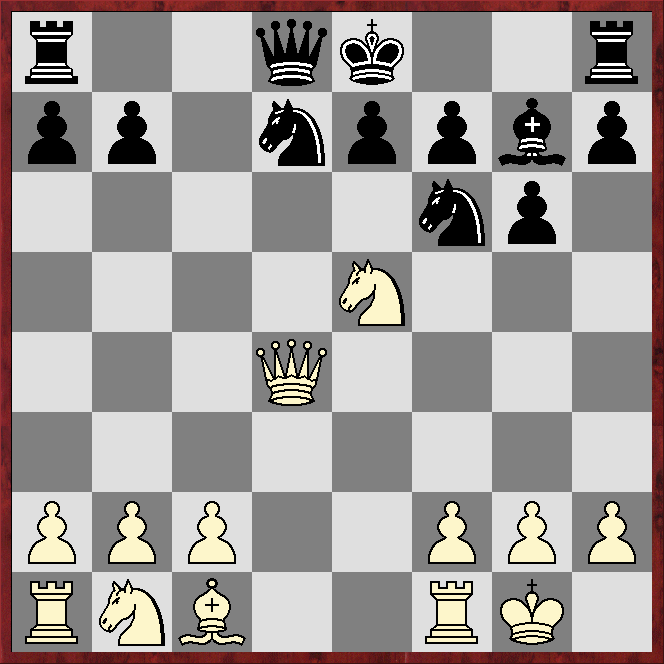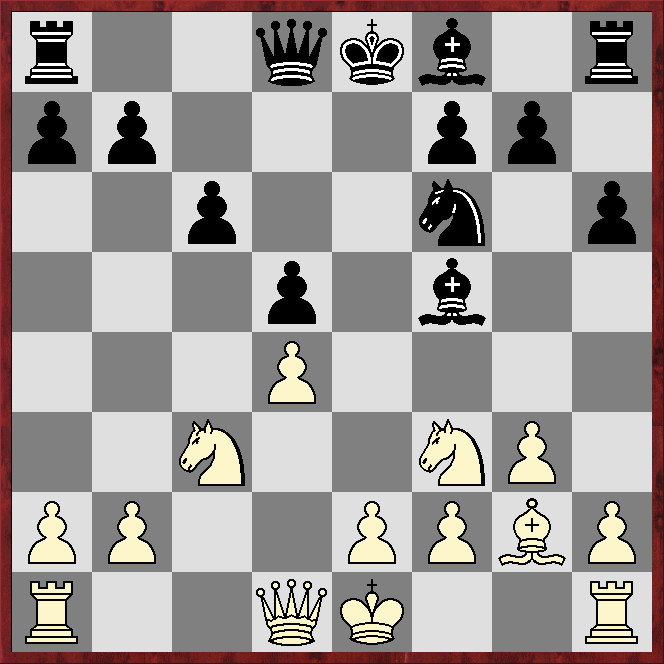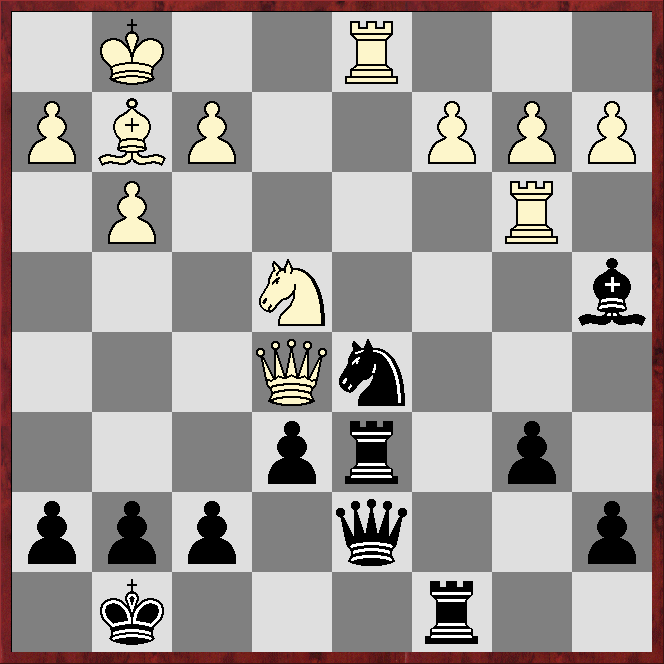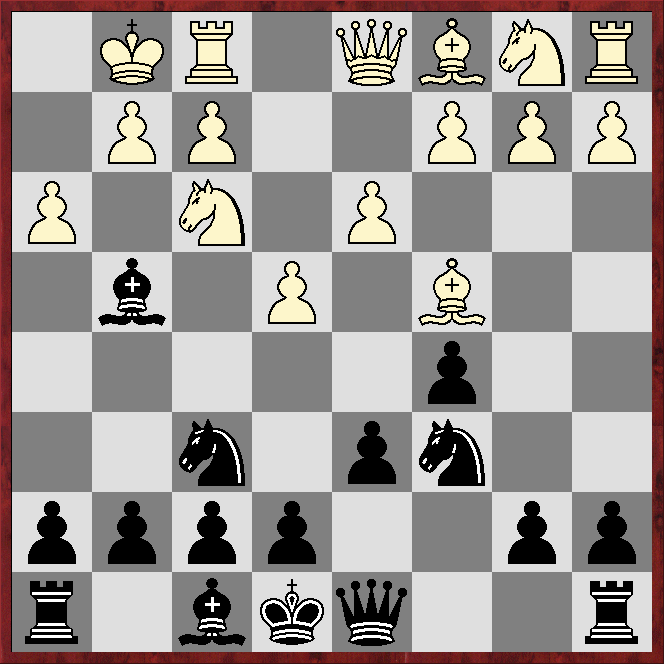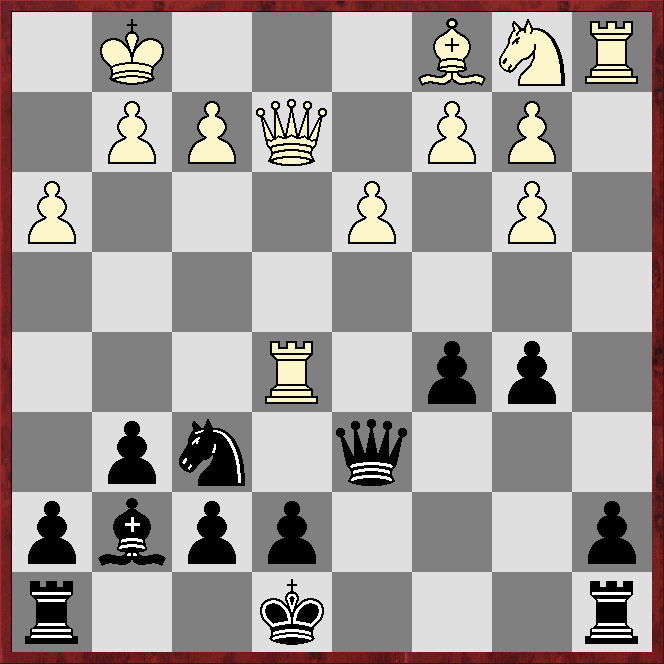HERE is another piece I wrote in the covid panic but but did not publish.
In this series I am looking at the statistically best way to play against popular opening lines.
The numbers are drawn from the 2021 edition of ChessBase's Mega database, ignoring, where possible, those results that include very few games and so are statistically insignificant.
The Benko Gambit: 1.d4 Nf6 2.c4 c5 3.d5 b5!? is especially popular at club level.
White scores a disappointing 52% by accepting with 4.cxb5, but an impressive 60% by declining with 4.Nf3.
 |
| Position after 4.Nf3 |
Black has six popular replies.
A) 4...g6 (2,378 games)
After 5.Qc2 the line splits.
A1 5...bxc4 6.e4, after which the line splits again.
A1.1 6...d6 7.Bxc4 Bg7 8.0-0 0-0 9.Re1!?, when A1.1a 9...Nbd7 10.h3 Nb6 11.Na3!? scores 79% for White, albeit from a small sample, and A1.1b 9...Ba6 10.Na3 Nfd7!? 11.Rb1 scores 80% for White, albeit from a small sample.
A1.2 6...Bg7 7.Bxc4, when A1.2a 7...d6 is a transposition to A1.1, and A1.2b 7...0-0 8.0-0 d6 is also a transposition to A1.1.
A2 5...d6 6.e4 Bg7 (6...bxc4 is a transposition to A1.1) 7.cxb5!?, after which the line splits again.
A2.1 7...a6 8.Nc3 0-0 9.a4, when A2.1a 9...axb5 10.Bxb5 Na6 11.h3 scores 88% for White, albeit from a small sample, and A2.1b 9...e6 10.dxe6 scores 75% for White.
A2.2 7...0-0 8.Nc3 a6 is a transposition to A2.1.
A3 5...Bg7 6.e4, after which the line splits again.
A3.1 6...d6 is a transposition to A2.
A3.1 6...0-0 7.cxb5 a6 8.a4 scores 58% for White, albeit from a small sample.
B) 4...Bb7 (1,350 games)
After 5.Nbd2 the line splits.
B1 5...bxc4 6.e4 e6 7.dxe6, after which the line splits again.
B1.1 7...dxe6 8.Bxc4 scores 75% for White, albeit from a small sample.
B1.2 7...fxe6 8.e5 Nd5 9.Nxc4 scores 57% for White, albeit from a small sample.
B2 5...e6 6.dxe6!? fxe6 (there are no games with 6...dxe6!? in Mega21) 7.e4!? scores 75% for White, but from just two games. Those games continued 7...Nxe4 8.Nxe4 Bxe4, when Stockfish13 and Komodo12.1.1 like the 9.Ng5 of Dorian Rogozencko (2490).
C) 4...bxc4 (770 games)
After 5.Nc3 the line splits.
C1 5...d6 6.e4, after which the line splits again.
C1.1 6...g6 7.e5!? dxe5 8.Nxe5 Bg7 9.Bxc4 0-0 10.0-0, when C1.1a 10...Nfd7!? 11.Nxf7! Rxf7 12.d6 scores 76% for White, and C1.1b 10...Bb7 11.Re1 scores 80% for White.
C1.2 6...Nbd7 7.Bxc4 g6 8.0-0 Bg7 9.a4!? 0-0 10.h3 Rb8 11.Re1 scores 57% for White, albeit from a small sample.
C2 5...g6 6.e4 d6 is a transposition to C1.1.
D) 4...d6 (604 games)
After 5.Qc2!? the line splits.
D1 5...g6 is a transposition to A2.
D2 5...bxc4 6.e4 g6 is a transposition to A1.1.
E) 4...e6 (435 games)
After 5.Bg5 the line splits.
E1 5...exd5 6.cxd5, after which the line splits again.
E1.1 6...d6 7.e4 a6 8.a4, when E1.1a 8...Be7 9.Bxf6!? Bxf6 10.Qc2 scores 71% for White, and E1.1b 8...b4 9.Nbd2 Be7 10.Be2 scores 83% for White, albeit from a very small sample.
E1.2 6...h6 7.Bxf6 Qxf6 8.Qc2, when E1.2a 8...d6 9.e4 a6 10.a4 b4 11.Bd3!? scores 80% for White, albeit from a small sample, and E1.2b 8...Be7 9.e4 Qb6!? 10.Be2 0-0 11.0-0 scores 67% for White, albeit from a very small sample.
E1.3 6...Qa5?! 7.Nc3!? Ne4 8.Bd2 Nxd2 9.Nxd2 scores 82% for White.
E2 5...Qa5+ 6.Nbd2!?, after which the line splits again.
E2.1 6...bxc4 7.Bxf6 gxf6 8.e4 Rg8 9.g3 scores 79% for White, albeit from a small sample.
E2.2 6...Ne4?! 7.b4! Qxb4 8.Rb1 Qc3 9.Rb3 Qa5 10.Rxb5 Qc3 11.Rb3 Qa5 12.Bf4 scores 100% for White, albeit from a small sample.
E3 5...h6 6.Bxf6 Qxf6 7.Nc3 b4 8.Nb5, after which the line splits again.
E3.1 8...Kd8 9.a3!? scores 83% for White, albeit from a small sample.
E3.2 8...Na6 9.e4 e5 10.a3 scores 79% for White, albeit from a small sample.
E4 5...b4 6.e4 d6 7.a3!? scores 65% for White, albeit from a small sample.
E5 5...bxc4 6.Nc3, after which the line splits again.
E5.1 6...d6 7.e4, when E5.1a 7...e5 reaches a position where both 8.Bxc4 and 8.Nd2!? score 56%, albeit from small samples, and E1.5b 7...Be7 8.Bxc4 scores 68% for White.
E5.2 6...Qb6 7.e4!? scores 100% for White, albeit from a small sample.
F) 4...b4 (380 games)
After 5.b3!? the line splits.
F1 5...g6 6.Bb2 Bg7 7.e4 scores 80% for White, albeit from a small sample.
F2 5...d6 6.Bb2 g6 7.Nbd2 Bg7 8.g3 0-0 9.Bg2 a5 10.0-0 scores 75% for White, albeit from a very small sample.



